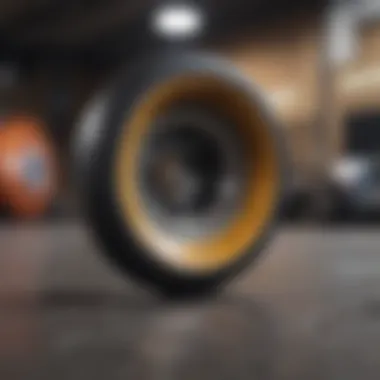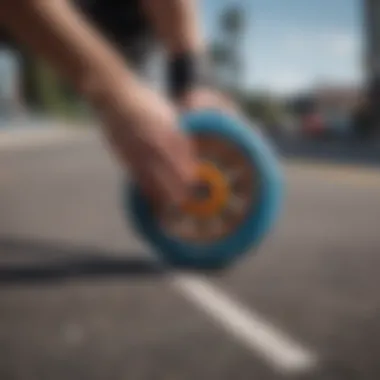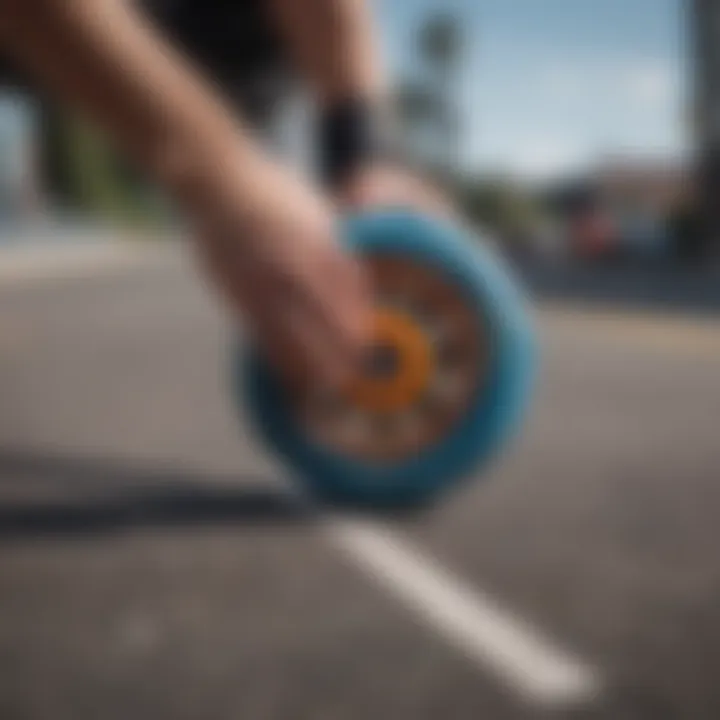Exploring 48mm Skateboard Wheels: Performance Insights


Intro
In the realm of skateboarding, the choice of wheels significantly influences performance and rider experience. One crucial size that skaters often consider is 48mm. This article delves into the intricate dynamics of 48mm skateboard wheels, aiming to provide a detailed perspective on their design, material makeup, and how they perform in various environments and styles. Whether you are a beginner seeking knowledge or a seasoned athlete refining your approach, understanding these wheels is essential.
Techniques and Tips
Skill Development
To maximize the potential of 48mm wheels, it is crucial to develop skills suitable for their performance characteristics. These small wheels offer unique advantages, such as enhanced control and responsiveness, which can benefit technical tricks. Start by focusing on balance and foot placement. The size of these wheels can provide feedback on your movements, helping refine your technique over time.
Practical Techniques
Utilizing 48mm wheels requires specific techniques to optimize performance:
- Carving and Turning: Smaller wheels provide sharper turns. Practice initiating turns with your shoulders and feet simultaneously to maintain balance.
- Ollies and Tricks: The responsiveness of 48mm wheels can aid in executing tricks like ollies or flips, provided the rider maintains a low center of gravity.
- Setups: Consider pairing these wheels with a slightly stiffer deck to enhance stability during high-speed tricks.
Common Mistakes to Avoid
It is easy to overlook certain aspects when using 48mm wheels. Be mindful of the following pitfalls:
- Neglecting Terrain: Small wheels may not perform well on rough surfaces. Opt for smoother terrains for optimal execution.
- Overestimating Durability: Although quality wheels possess resilience, understand that 48mm wheels may wear faster under intense use compared to larger options.
- Inappropriate Fit: Ensure your setup complements the wheels’ size, as compatibility is critical for performance.
Gear and Equipment
Essential Gear for Beginners
New skaters venturing into the world of small wheels must equip themselves appropriately:
- Protective Gear: Prioritize helmets, knee pads, and elbow pads to safeguard against falls.
- Quality Skateboard: Invest in a durable deck designed for your weight and riding style. A solid truck and bearing system can drastically improve overall experience.
Latest Innovations and Trends
The skateboarding industry continually evolves. Recent trends highlight the use of urethane compounds in wheels, improving grip and durability. Additionally, manufacturers are leaning towards eco-friendly materials. Innovations focus on enhancing shock absorption and reducing the risk of flat spots.
Reviews and Comparisons
Choosing the right wheels involves evaluating products based on performance:
- Bones SPF Wheels: Known for their smooth ride and resilience, ideal for street skating.
- OJ Wheels: Offers an excellent balance of grip and durability, suitable for various skating styles.
Safety Measures
Essential Safety Gear
Safety should always come first when skating with 48mm wheels. Recommended gear includes:
- Helmets: Ensure it fits properly and meets safety standards.
- Wrist Guards: Protects against common injuries when falling.
Best Practices for Safe Participation
Adhere to the following practices to enhance safety:
- Check Equipment: Always inspect your skateboard for wear and tear before each session.
- Warm-Up: Like any sport, a good warm-up can help prevent injuries.
Injury Prevention and Management
Despite precautions, injuries can occur. Recognize early signs of strain and manage accordingly.
- Rest: Give your body time to recover from intense sessions.
- Rehabilitation Exercises: Engage in strengthening routines to support vulnerable areas, especially wrists and ankles.
Spotlights on Extreme Sports
Featured Sport of the Month
For this month, we highlight Street Skateboarding, its dynamic nature makes it a perfect match for 48mm wheels. The rapid changes in direction and precision required align seamlessly with the wheel’s characteristics.
Profiles of Prominent Athletes
Athletes like Nyjah Huston display the versatility of smaller wheels in their impressive tricks. Their performances help to advance techniques within the community, inspiring skaters at all levels.
"Understanding your skateboard setup, especially wheel size, can elevate your performance and confidence on the board."


With this foundational knowledge of 48mm skateboard wheels, skaters can make informed choices that enhance their skills while ensuring safety.
Prelims to Skateboard Wheels
Skateboard wheels are a fundamental component of any skateboard. They directly impact the rider's experience and performance. Understanding their characteristics is essential for both new and seasoned skaters. In this section, we will delve into what skateboard wheels are and why their size matters.
Defining Skateboard Wheels
Skateboard wheels are circular discs that sit at the ends of the skateboard's trucks. Their primary function is to allow the skateboard to roll. Wheels are made from polyurethane, a durable material that provides a smooth ride and grip on various surfaces. They come in various sizes and hardness ratings. Most skateboard wheels measure between 48mm and 60mm in diameter. The diameter indicates how well the skateboard handles and what type of skating it best suits. Finding the right size can significantly influence performance.
Importance of Wheel Size
Wheel size is crucial when selecting skateboard wheels, as it influences stability, acceleration, and tricks. Smaller wheels, like the 48mm ones, offer agility, making them ideal for technical tricks and street skating. They are often preferred for their quick responsiveness and ability to facilitate precise movements. Conversely, larger wheels tend to provide more speed and a stable ride, suitable for ramp and vert skating.
Choosing the right size involves considering the rider's style and preferred terrain. For example, a street skater may opt for smaller wheels, while a vert skater favors larger ones.
"Understanding the nuances of skateboard wheels, including size, shape, and hardness, empowers riders to tailor their setups and enhance their skills."
Through this investigation, we will unpack the specific features of 48mm skateboard wheels in the upcoming section.
Specific Features of 48mm Skateboard Wheels
Understanding the specific features of 48mm skateboard wheels is crucial for any skateboarder who aims to optimize their performance. This diameter class provides unique characteristics that influence speed, control, and the overall skating experience. Skateboard wheels are not simply a component; they are integral to how a rider interacts with various surfaces and environments. This section will delve into the diameter implications, hardness ratings, and the materials used in these wheels, all of which significantly affect functionality and rider preference.
Diameter and Its Implications
The diameter of a skateboard wheel is one of the primary factors determining its performance. In the case of 48mm wheels, a smaller size influences not only speed but also the rider's ability to perform technical tricks. The reduced diameter allows for quicker acceleration. Skaters can navigate through tight spaces and execute intricate maneuvers with greater ease.
However, this smaller size also brings some trade-offs. The reduced wheel diameter can create a rougher ride on imperfect surfaces. Riders might find themselves feeling more of the vibrations from cracks and bumps, which might affect fatigue and control. Therefore, it is essential for skaters to consider the kinds of terrain they will mostly encounter. In summary, the wheel diameter is directly linked to performance capabilities and skater capabilities.
Hardness Ratings Explained
Hardness ratings measure the durometer of skateboard wheels, which is an indicator of their softness or hardness. For 48mm wheels, hardness is especially significant as it directly impacts grip, slide characteristics, and ride quality. Typically, wheel hardness is rated on a scale from 78A to 101A, with lower numbers indicating softer wheels.
Common hardness classifications include:
- Soft Wheels (78A - 86A): Offer better grip and shock absorption, suitable for rough surfaces.
- Medium Wheels (87A - 95A): A balance that allows for decent grip while still being responsive for tricks.
- Hard Wheels (96A and above): Provide less grip but excel in speed and slide control on smooth surfaces.
Choosing the right hardness can be the difference between an average and an exceptional performance, depending on skating style and preferences.
Materials Used in Construction
The construction materials of skateboard wheels directly determine their performance and durability. Generally, 48mm wheels are made from urethane, which is renowned for its resilience and ability to absorb shock. Urethane wheels provide the right balance of grip and hardness, catering to both street skating and park use.
There can be variances in the quality of urthane, leading to differences in performance. Some wheels incorporate additives for strength or responsiveness. These variations allow for customization based on specific skating styles or personal preferences.
Understanding these materials is important for anyone looking to invest in skateboard wheels. Just as any gear in extreme sports, the right wheel can enhance overall experience and skating efficiency.
"Selecting the right skateboard wheel is imperative for peak performance and enjoyable skating."
Skaters must consider how the diameter, hardness, and materials come together to create a wheel that meets their needs. Armed with this knowledge, riders are better equipped to choose the optimal 48mm skateboard wheel for their style.
Performance Attributes of 48mm Wheels
The performance attributes of 48mm skateboard wheels play a vital role in the overall experience of a rider. These wheels are strategically designed to enhance speed, control, and durability. Their characteristics contribute not only to the types of tricks and maneuvers a rider can execute but also influence the choice of skating environment.
Speed and Acceleration
Speed is essential in skateboarding, and 48mm wheels offer unique advantages in this area. Their smaller diameter allows for quicker acceleration compared to larger wheels. This rapid response is beneficial for technical riding styles where speed is often necessary to perform tricks. In practical terms, riders can achieve peak velocities swiftly, especially during street skating or when navigating tight spaces. This becomes particularly valuable in competitive environments where fractions of a second can make a difference in performance.
- Lightweight Design: The 48mm wheels are lighter which aids in achieving higher speeds.
- Reduced Rolling Resistance: Smaller wheels encounter less drag, enhancing acceleration capability.
Control and Stability
Control is paramount when riding skateboards, and 48mm wheels excel in providing it. Their size cultivates a lower center of gravity, assisting with balance and precision during tricks. This feature is essential for street skaters who require tight turns and quick responses to changing environments. However, it is important to note that while smaller wheels can sometimes sacrifice stability at high speeds due to their reduced contact surface area, many riders find that they can maneuver effortlessly through urban landscapes.
"The control offered by narrower wheels allows for improved manipulation of the board, which is critical for more complex trick sequences."
- Better Feedback: The smaller size helps riders feel the terrain better.
- Enhanced Maneuverability: Riders can execute tighter turns and more controlled slides.
Durability and Longevity


Durability is another significant attribute of 48mm wheels. When put through their paces, these wheels demonstrate the ability to withstand the rigors of skateboarding. Constructed from high-quality urethane, they can resist flat spots and abrasions, maintaining performance over time. The longevity of these wheels can be an important factor for serious skateboarders who engage in regular practice or competition.
- Resistant to Wear: Urethane material provides durability in various conditions.
- Impact Resistance: Smaller wheels are designed to handle shocks, leading to fewer replacements.
In summary, the performance attributes of 48mm wheels significantly impact a skater's experience. Understanding these aspects can help riders make informed choices for their skateboarding gear.
Ideal Skating Styles for 48mm Wheels
When considering skateboarding wheels, the size plays a crucial role in determining the performance and suitability for various skating styles. This section focuses on the ideal skating styles for 48mm wheels, highlighting their benefits and considerations.
Technical Tricks and Street Skating
Technical tricks and street skating are foundational components of skateboarding culture. Riders often require a wheel that offers maneuverability and responsiveness. The 48mm size strikes a balance, enabling quick rotations and flips. This size is particularly beneficial when performing tricks that require precision, such as ollies and kickflips.
Moreover, many street spots have rough terrain. Smaller wheels, like 48mm, enable skaters to navigate such conditions while minimizing the risk of losing balance. This wheel size allows for tighter turns, which is essential in executing tricks around obstacles found in urban environments.
"For technical street skating, the responsiveness of 48mm wheels enhances trick execution, providing skaters with greater control."
Vert and Ramp Use Cases
While 48mm wheels are often associated with technical tricks, they also have their place in vert skating and ramp use. When skating vert, having a smaller wheel can actually improve stability on steep transitions. The size allows for rapid acceleration, making it easier to gain speed for tricks and aerial maneuvers.
However, it is important to consider the rider's weight and skill level. Lighter skaters may find these wheels responsive in maintaining speed while pumping through transitions. Conversely, heavier riders might experience less control, especially when attempting aggressive tricks at height.
In general, the key takeaway for skating on ramps and in vert parks with 48mm wheels is adaptability. With the right techniques, riders can utilize these wheels effectively to execute their desired tricks.
In summary, the ideal skating styles for 48mm wheels encompass both technical street skating and vert use. Each style leverages the unique features of this wheel size, allowing riders to excel in various skating environments while enjoying the thrill of the sport.
Comparative Analysis with Other Wheel Sizes
In understanding the dynamics of skateboarding wheels, a comparative analysis of different sizes is crucial. The size of a skateboard wheel significantly affects various performance metrics, including speed, maneuverability, and stability. By examining how 48mm wheels stack up against other common sizes, riders can make an informed decision that meets their unique needs. This comparison is particularly relevant for skaters who engage in specific styles, as different wheel sizes cater to different skating experiences.
Contrasting 48mm with 50mm Wheels
When comparing 48mm wheels to 50mm ones, there are several key distinctions to consider. The most notable difference is in diameter, which impacts the ride quality. 50mm wheels are larger, providing better shock absorption and a smoother ride on rough surfaces. This makes them preferable for street skating and ramps where uneven terrain is common. The increased size also contributes to enhanced grip, which is critical for executing tricks and controlling speed.
On the other hand, 48mm wheels offer a lower center of gravity. This can be advantageous for technical tricks and tricks that require balance. The smaller diameter allows skaters to maintain higher speed on smooth surfaces while enabling faster rotations in complex maneuvers. Riders who favor technical street skating may prefer the responsiveness of 48mm wheels, as they are more conducive to quick adjustments and intricate footwork.
Several factors influence the choice between 48mm and 50mm wheels, including personal preference and individual skating style. Those who frequently skate smooth skateparks may opt for 48mm wheels for their agility, while those encountering more diverse terrains might choose 50mm wheels for their stability and comfort.
Evaluating 54mm and Larger Options
Moving to 54mm wheels and larger options, the differences broaden. Wheels in this size range provide more surface area, which translates to greater speed and a smoother ride over various surfaces. Larger wheels are particularly suitable for riders embracing a cruising style or those who enjoy downhill skating. The additional diameter not only enhances rolling speed but also allows for better clearance over obstacles, making them ideal for navigating urban landscapes with curbs and bumps.
However, larger wheels introduce trade-offs. They tend to be heavier, which can hinder the ability to perform advanced tricks that rely on rapid foot movement and flicking the board. Additionally, a larger wheel size can reduce the level of control during precise maneuvers, a critical aspect for technical skating.
According to some skaters, larger diameters can also affect pop during ollies. For freestyle and technical skaters, maintaining a balance between wheel size and performance characteristics is essential. The choice often boils down to maximizing either performance in larger, open environments or precision and control in confined spaces.
"Understanding the nuances of wheel sizes can fundamentally alter your riding experience and performance."
In summary, contrasting 48mm wheels with 50mm and exploring the advantages of 54mm wheels provides critical insights for riders. This analysis reveals not only the functional aspects of skateboard wheels but also underlines how different sizes cater to a spectrum of skating styles and conditions.
Choosing the Right Wheel for Your Setup
Selecting the appropriate skateboard wheel is a critical aspect that can greatly influence the overall skating experience. Each wheel size, including the 48mm variety, is tailored to specific riding conditions and styles. These wheels not only affect speed but also impact control, stability, and comfort. Understanding these factors must be the first step in optimizing personal setups for better performance.
Factors to Consider
When choosing wheels, several parameters should be assessed:
- Diameter: The size of the wheel directly relates to how it grips the terrain. For example, 48mm wheels are typically favored for trick skating, especially in urban settings.
- Hardness: The durometer rating indicates the hardness of the wheel. Softer wheels provide better grip, while harder wheels allow for faster speeds. Understanding your riding style will dictate the right rating.
- Surface Area: Wider wheels offer more stability on grinds and slides but may not perform as well in tricks due to increased friction.
- Material: Different materials affect durability and performance. Urethane wheels are common for their balance between grip and wear.
Considering these factors allows skaters to make informed choices tailored to their specific needs. Different styles and environments necessitate various wheel specifications, and acknowledging them can enhance performance significantly.
Personal Riding Style Assessment
To make the best choice regarding wheel selection, skaters need to reflect on their personal riding style. Is it primarily street skating, technical tricks, or vert? Each style has different demands on wheel features:
- Street Skating: This style often requires wheels that balance speed with maneuverability. Riders should favor smaller sizes like 48mm, which are responsive for quick tricks.
- Technical Tricks: For complex movements, 48mm wheels offer a good platform, allowing for easier flicks and momentary lifts.
- Vert and Ramp Skating: Although larger wheels are typically favored in this area, understanding your trick repertoire may lead you back to smaller options like the 48mm for specific scenarios.
Ultimately, riders should assess how often they perform each type of skating and under what conditions they skate. What’s beneficial for one style might not be suitable for another. A combined understanding of both wheel specifications and personal preferences is necessary to ensure the best setup.


"Choosing the right wheels involves understanding both the technology behind them and your own riding habits. Striking the balance between the two can elevate your skating performance to the next level."
Maintenance and Care for 48mm Wheels
Taking proper care of your 48mm skateboard wheels is essential for preserving their performance and extending their lifespan. Maintenance might seem an afterthought for some skaters, but consistent care can make a substantial difference in how well these wheels perform.
Benefits of Regular Maintenance
- Improved Performance: Maintaining optimal wheel condition allows for smoother rides and better control.
- Enhanced Durability: Regular checks and timely adjustments help in preventing wear and tear.
- Safety: Well-maintained wheels contribute to a safer skating experience, reducing the risk of accidents due to equipment failure.
Thus, understanding how to properly maintain your wheels should be regarded as key knowledge for every serious skater.
Routine Checks and Adjustments
Regular inspections are vital for the long-term performance of 48mm wheels. Here are some specific aspects to check:
- Axle Tightness: Ensure that the nuts on the axles are tightened properly. Loose parts can cause wobbling and affect your balance.
- Wheel Wear: Check for flat spots, cracks, or chips. If you notice these signs, it might be time to replace the wheels to avoid compromising your ride.
- Bearing Condition: Wheel bearings should spin freely. If you hear grinding noises, it’s a warning sign that they may need cleaning or replacing.
Setting a schedule for these checks can be beneficial. For instance, inspecting your wheels every few skating sessions can help catch issues early.
Cleaning and Handling Techniques
A clean wheel performs better and lasts longer. Here are effective cleaning tips for your 48mm wheels:
- Washing: Use warm soapy water and a cloth or sponge to clean the surface. Avoid using harsh chemicals that can damage the material.
- Drying: After washing, dry your wheels thoroughly to prevent rusting of the bearings.
- Bearing Cleaning: To clean the bearings, remove them from the wheel and soak them in a solvent like rubbing alcohol. This helps remove dirt and grime. After soaking, dry them well before reassembly.
Handling Recommendations
Never leave your skateboard in direct sunlight for prolonged periods. The heat can warp or damage the wheels. Also, avoid riding it on wet surfaces, as moisture can lead to degradation of both wheels and bearings.
Consistent care and proper handling of 48mm wheels not only maintain performance but also ensure a safer skating experience over time.
The Evolution of Skateboard Wheel Technology
Understanding the evolution of skateboard wheel technology is essential for grasping the significance of 48mm skateboard wheels. Over the decades, various innovations in wheel design, materials, and manufacturing techniques have influenced both performance and rider experience. A focus on this evolution reveals how advancements have directly impacted styles of skating. With 48mm wheels being a product of these developments, their characteristics reflect years of refinement.
Historical Perspective
The history of skateboard wheels begins in the 1960s, when early models used solid wooden wheels. As skateboarding grew, polyurethane wheels emerged in the 1970s. This was a turning point because polyurethane offered better grip and shock absorption. Early designs were somewhat larger and softer, serving a different purpose than today’s wheels. The evolution to smaller wheel sizes like 48mm began in the 1980s. This shift coincided with the rise of street skating and technical tricks, prompting the need for wheels that allowed precision and control on flat surfaces and obstacles.
Key milestones in this history include:
- The shift from clay to polyurethane in the 1970s helped in enhancing performance.
- The introduction of wheel shapes like square-edged designs catered to technical skating.
- The advent of different hardness ratings allowed skaters to choose wheels based on their style.
Each of these developments played a crucial role, leading to the specialization of wheels, including the popularization of sizes like 48mm.
Future Trends and Innovations
Looking forward, the landscape of skateboard wheel technology continues to evolve. Innovations in materials and manufacturing processes promise to change how wheels perform. Some key trends include:
- Smart Material Use: Advancements in materials that enhance durability without sacrificing performance.
- Customization Options: Increased availability of customizable wheels to fit unique skating styles and personal preferences.
- Sustainability Efforts: Greater emphasis on eco-friendly materials that do not compromise on performance.
As brands continually push boundaries, we can expect to see lighter, more agile wheels that optimize both speed and responsiveness. The combination of historical knowledge and modern tech will likely shape skaters' experiences in unprecedented ways.
In summary, the evolution of skateboard wheel technology from its rudimentary beginnings to today’s advanced designs illustrates a commitment to enhancing the skating experience. This trajectory not only explains the presence and significance of 48mm wheels but also sets the stage for the future of skateboarding.
Culmination and Final Thoughts
The exploration of 48mm skateboard wheels provides valuable insights into how wheel size influences performance in the sport of skateboarding. The attributes discussed throughout this article highlight the specific design and functionality of these wheels.
Understanding the dynamics of 48mm wheels is not just an academic exercise; it impacts real-world skateboarding experiences. The combination of speed, control, and maneuverability that these wheels offer makes them a strategic choice for riders targeting specific styles. Whether it is technical tricks on gritty streets or navigating ramps, recognizing the importance of wheel characteristics is essential for advanced skating techniques.
As trends in skateboard technology evolve, adhering to informed choices about equipment fosters better performance. Therefore, the discussions in this article empower riders to consider factors ranging from material to compatibility with riding styles.
Ultimately, the interplay between design, material composition, and rider preference shapes the effectiveness of 48mm wheels in the diverse landscape of skateboarding.
Summarizing Key Takeaways
- Performance: 48mm wheels offer a balance of speed and control tailored for technical tricks and street skating.
- Durability and Material: The materials used in constructing these wheels directly affect their longevity and performance under various conditions.
- Riding Style: The suitability of these wheels changes based on individual riding style, making it crucial to assess one's skating preferences.
- Maintenance: Regular upkeep is vital for maintaining the performance of skateboard wheels, especially in demanding environments.
Encouraging Informed Choices in Skateboarding
Choosing the right skateboard wheels, particularly the 48mm size, requires more than a surface-level understanding. Riders should assess their individual needs and skill levels to gain significant advantages from their equipment.
Factors such as the type of terrain, the emphasis on tricks versus cruising, and the rider's personal style play a vital role in selecting appropriate wheels.
Decisions supported by knowledge lead to better experiences in the sport. It's important to continually educate oneself about the advancements in wheel technology and performance attributes.
"Making informed choices about wheel size not only enhances performance but also aligns with the rider's goals and conditions."
Ultimately, a thoughtful approach, blended with considerations of wheels and riding styles, will contribute to overall satisfaction and success in skateboarding.







